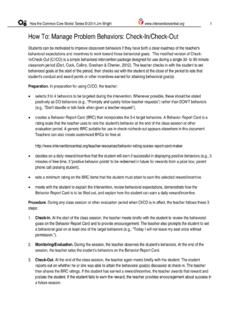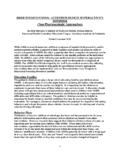Transcription of Antecedents, Positive Consequences, and Extinction …
1 Effective Behavioral interventions 2015 Jim Wright Antecedents, Positive Consequences, and Extinction Procedures: The Secret Ingredients for Creating a Better Behavior Intervention plan Behavior intervention plans are highly individualized--because every student displays a unique profile of behaviors. However, teachers will find that their chances of helping a student to engage in Positive behaviors increase when they include each of these 3 elements in their classroom behavior intervention plans: 1. Antecedents: Strategies to promote Positive behaviors and prevent misbehavior 2. Positive consequences: Responses that increase Positive /goal behaviors 3. Extinction procedures: Responses that extinguish problem behaviors Every one of these elements plays a crucial role in promoting the success of a behavior plan .
2 Antecedent strategies prevent the student from engaging in problem behaviors in the first place. Positive consequences motivate the student to show desired behaviors, such as academic engagement. Extinction procedures remove the 'pay-off' to the student for engaging in problem behaviors. While any one of the elements might be inadequate to change the student's behavior, the combination of antecedents, Positive consequences, and Extinction procedures can result in a strong, flexible plan and successful intervention outcome. Teachers can use this guide to build their own behavior plans using its research-based ideas for antecedents, Positive consequences, and Extinction procedures. ADHD:ODD (Oppositional Defiant Disorder):GAD (Generalized Anxiety Disorder) 1. Antecedents: Strategies to Prevent Misbehavior Teachers have the greatest array of options to influence a student to engage in Positive behaviors when they focus on antecedents: actions they take before the student behavior occurs.
3 Proactive antecedent actions to encourage desired behaviors are often quick-acting, can prevent misbehavior and attendant interruption of instruction, and usually require less teacher effort than providing corrective consequences after problem behaviors have occurred. Teacher strategies to elicit Positive student behaviors include making instructional adjustments, providing student prompts and reminders, and teaching students to monitor and evaluate their work performance. Here are specific antecedent ideas that teachers can use to 'nudge' students to engage in desired behaviors: Antecedents That Prevent Problem Behaviors ADHD:ODD:GAD: Behaviors: Teach Expectations (Fairbanks, Sugai, Guardino, & Lathrop, 2007). Students must be explicitly taught behavioral expectations before they can be held accountable for those behaviors.
4 The teacher should model Positive behaviors, give students examples and non-examples of appropriate behaviors to clarify understanding, have students practice those behaviors with instructor feedback; and consistently acknowledge and praise students for successfully displaying Positive behaviors. ADHD:ODD:GAD: Instructional Match: Ensure the Student Can Do the Work (Burns, VanDerHeyden, & Boice, 2008). Student misbehavior frequently arises from an inability to do the academic task. When the student 4 Jim Wright, Effective Behavioral interventions 2015 Jim Wright lacks skills necessary for the academic task, the instructor teaches the necessary skill(s). Additional strategies include adjusting the immediate task to the student's current skill(s) and pairing the student with a helping peer.
5 ODD: No: Substitute a Preferred Alternative (Mace, Pratt, Prager, & Pritchard, 2011). If the student has a pattern of misbehaving when told that he or she cannot access a desired item or engage in a preferred activity, the teacher can use the 'no with preferred alternative' strategy. The teacher prepares by making a list of activities or items preferred by the student that are allowed during the academic situation or setting where problems arise. Then, whenever the student requests an item or activity that is not allowed, the teacher (1) tells the student that he or she cannot access the desired activity or item; (2) provides a brief explanation of why the requested item or activity is off-limits; and (3) immediately offers the student one or more items or activities from the prepared list that are allowable in the current situation or setting.
6 ADHD:ODD: Relocate the Student: Remove From Temptation (US Department of Education, 2004). When the student's problem behaviors are triggered or supported by factors in the environment--such as a talkative peer or difficulty hearing or seeing the instructor--the teacher may choose to move the student to another, less-distracting location in the classroom. A good option is to seat the student within the teacher's 'action zone', close to the instructor and in the region of the room toward which that educator directs most instruction. ADHD:ODD:GAD: Schedule: Increase Predictability (Kern & Clemens, 2007). When students know the content, duration, and/or consequences of future events (Kern & Clemens, 2007; p. 67), their level of engagement rises and problem behaviors decline a good definition of motivation.
7 A strategy to increase the predictability of events for individual students or an entire classroom is to post or otherwise provide a schedule outlining the day's classroom activities. In simplest form, such a schedule lists a title and brief description for each scheduled activity, along with the start and end times for that activity. Teachers may wish to add information to the schedule, such as helpful reminders of what work materials a student might need for each event. Students who have difficulty interpreting a written schedule may benefit from having their schedules read aloud and/or from having pictorial equivalents included in their schedules. ODD:GAD: Work Break: Make It Available on Request (Majeika et al., 2011). Sometimes misbehavior is an attempt by the student to engineer a break from an academic task.
8 The teacher can choose an alternative method for the student to use to communicate that he or she would like a brief break, such as requesting that break verbally or pulling out a color-coded break card. Of course, the student will also require clear guidelines on how long the requested break will last and what activities are acceptable for the student to engage in during that break. Antecedents That Encourage Goal Behaviors ADHD:ODD:GAD: Checklist for Academic Skills: Make the Complicated Simple (Alter, Wyrick, Brown, & Lingo, 2008). When the student must apply several steps to complete a complex academic task, the teacher can give the student a checklist detailing each step and instructions for completing it. Before the activity, the student is prompted to preview the checklist; after the activity, the student uses the checklist to review the work.
9 ADHD:ODD:GAD: Checklist for Challenging Situations: Script Transition Times (McCoy, Mathur, & Czoka, 2010). Students often struggle with the complexity of managing multi-step routines such as transitioning between classroom activities or moving to different locations within the school. Teachers can assist by making up step-by-step checklists that 'walk' the student incrementally through the routine. Instructors can use these checklists as 5 Jim Wright, Effective Behavioral interventions 2015 Jim Wright guides to teach and measure student success in navigating transitions. Just as important, the student can use the checklist as a prompt and guide to follow the expected steps. ADHD:ODD:GAD: Choice-Making: Allow for Student Preference (Green, Mays, & Jolivette, 2011).
10 Students find it motivating to have opportunities to choose how they structure or carry out their academic tasks. Teachers can allow choice on any of a variety of dimensions of a classroom activity, such as where the activity takes place; who the child works with; what materials to work with ( , choosing a book from several options); when to begin or end the activity; or how long to engage in the activity. ADHD:ODD:GAD: Fix-Up Skills: Foster Work Independence (Rosenshine, 2008). During independent work, the student should know procedures to follow if stuck ( , cannot complete an item; does not understand a word in a reading passage). The teacher creates a routine for the student in how to apply 'fix-up' skills for independent assignments: , "If I don't understand what I have read, I should (1) reread the paragraph; (2) slow my reading;(3) focus my full attention on what I am reading; (4) underline any words that I do not know and try to figure them out from the reading" (McCallum et al.)














